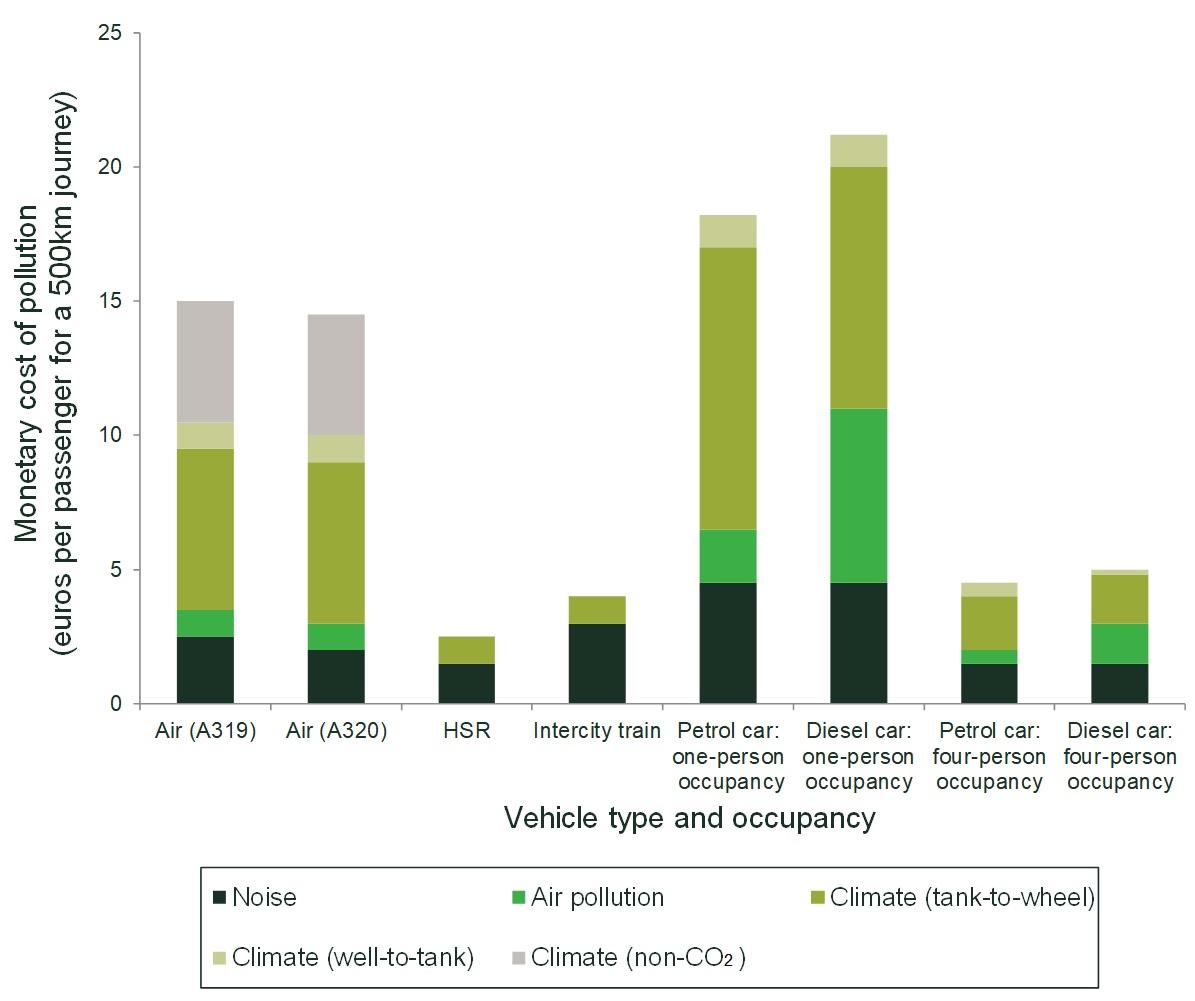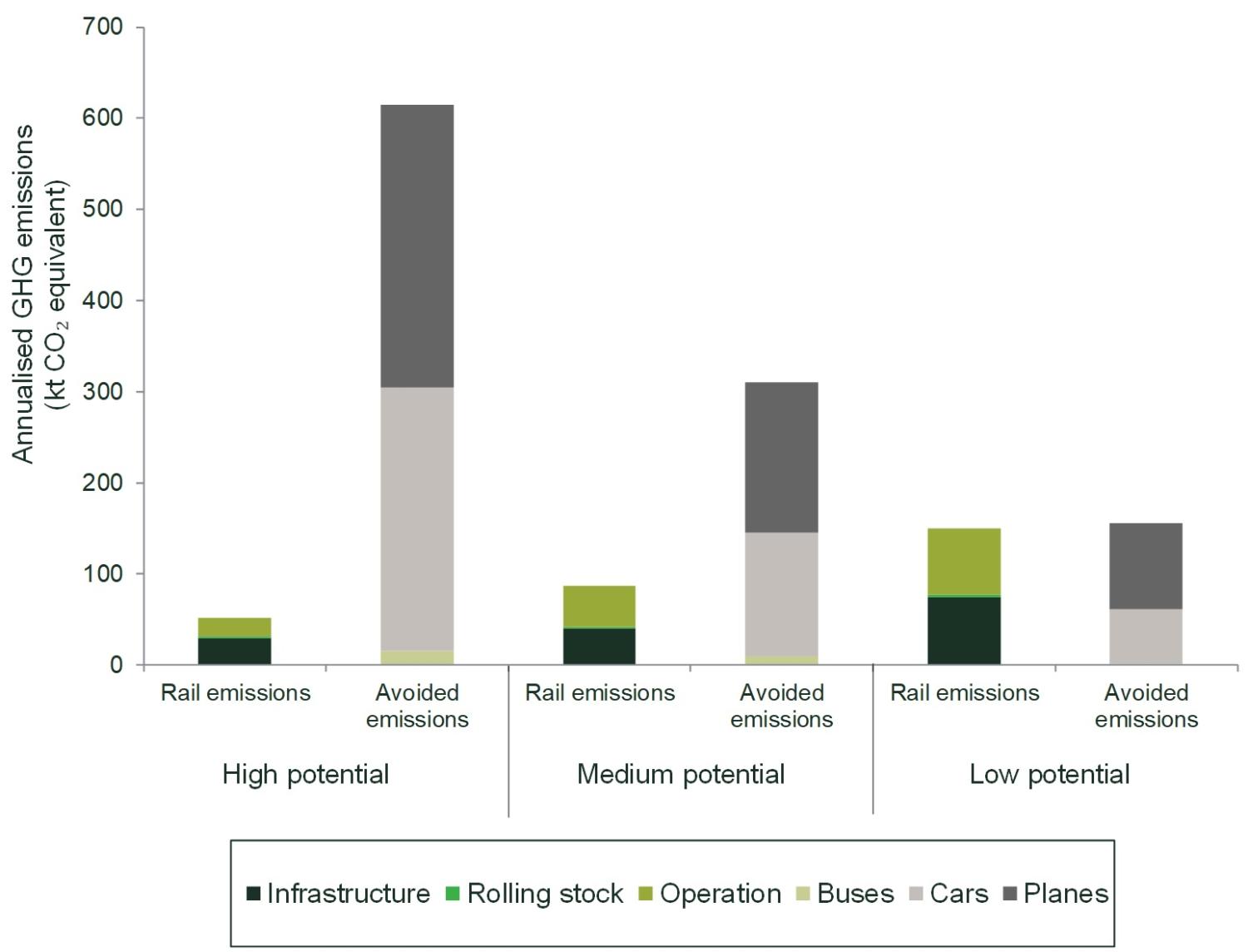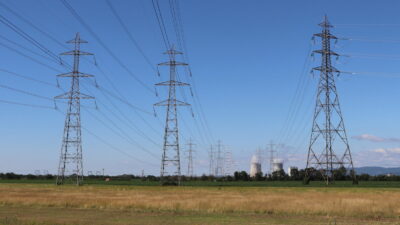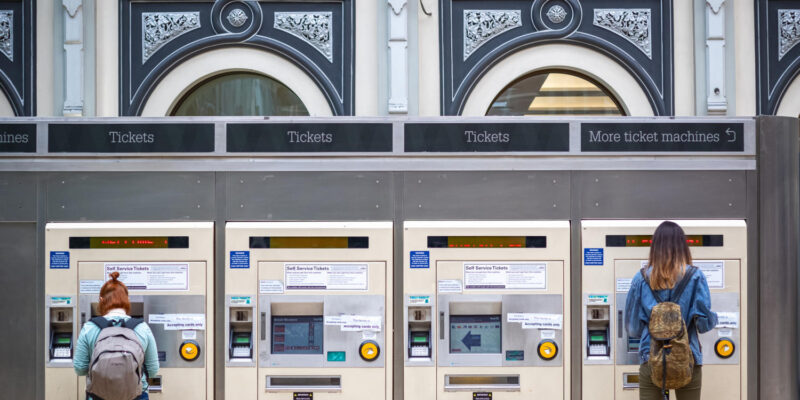Grounded? The environmental implications of modal shift from air to rail
With growing pressure on economies to decarbonise in line with the 2015 Paris Agreement, transport—and particularly air transport—has come under increased scrutiny. Moving passengers from air to rail has been proposed as one way to decarbonise the sector. To this end, the EU and national governments have invested in high-speed rail lines and discussed restrictions on short-haul flights. But does rail always trump air from an environmental perspective?
The EU plans to be climate neutral by 2050. As an intermediate step, it is aiming for a 55% net reduction in greenhouse gas emissions by 2030, relative to 1990 levels. Meanwhile, the transport sector is the fastest-growing source of emissions worldwide.1 Road traffic currently accounts for 72% of total greenhouse gas (GHG) emissions from transport (73% of passenger-kilometres), aviation accounts for 14% (8% of passenger-kilometres), and rail accounts for less than 1% (6% of passenger-kilometres).2
It is within this context that transport, and especially air transport, has come under the spotlight. In 2021, the EU proposed its ‘Fit for 55’ package, which targets emissions from sectors such as aviation through measures including a tax on jet fuel and phasing out free emissions allowances in the Emissions Trading System. The European Commission is also encouraging a modal shift from air to rail. For example, Executive Vice President of the European Commission, Frans Timmermans, has called for a limit on short-haul journeys by air and a modal shift to rail as one of several measures to ensure that all travel under 500km in Europe becomes carbon neutral.3 The Commission’s 2020 Sustainable and Smart Mobility Strategy focuses strongly on modal shift—for instance, setting a milestone that by 2030 ‘high-speed rail traffic will double across Europe’.4
These measures have been accompanied by large-scale investment in rail to make it a more attractive and viable alternative to air. Since 2000, the EU has provided €23.7bn in grants to co-finance high-speed rail (HSR) infrastructure, while the European Investment Bank has provided €29.7bn in loans over the same period.5
Several EU countries have also introduced national measures to encourage modal shift. In 2021, French lawmakers voted in favour of a law banning all short-haul domestic flights of less than 2.5 hours where there are rail alternatives, excluding connecting flights.6 In April 2022, Belgium introduced a new air tax of €10 for any departing flights under 500km,7 and in 2020 Austria imposed a ban on domestic flights with train alternatives under three hours.8 Bans on short-haul flights have also been considered in Germany and Spain. But how effective are these bans and taxes at reducing emissions? Oxera was asked by the European Regions Airline Association, Airports Council International Europe, the AeroSpace and Defence Industries Association of Europe, the Civil Air Navigation Services Organisation, and Airlines for Europe to assess the environmental impacts of both modes of transport, and the factors that need to be taken into account when assessing the impacts of a shift from air to rail.
What are the current CO2 impacts of aviation and rail?
Rail has significantly lower direct CO2 emissions than air transport, although estimates vary as to the scale of this difference. One study finds that travelling by air emits five to six times more emissions than an equivalent journey by train,9 while another proposes that, if flights were replaced by inter-city rail travel, the resulting emissions would be 20% lower.10
However, these comparisons often do not take account of all of the relevant factors when comparing the environmental impact of air and rail. For example, occupancy (or load factor) significantly affects emissions per passenger-kilometre. The emissions from a single-occupancy petrol or diesel car may be greater per passenger than from an aircraft at 80% capacity, as shown in Figure 1 below. Typically aircraft have higher load factors than conventional rail, reducing the emissions gap between the two modes of transport.11
Figure 1 Monetary cost of pollution for air, rail and car transport at different occupancy levels

Another factor that needs to be considered is the carbon cost of infrastructure associated with both modes of transport, including in terms of the construction and maintenance of airports and railway tracks. One source notes that indirect emissions, including from infrastructure, account for 21% of overall emissions from aviation, and 39% and 100% from diesel and electric trains respectively. Taking these indirect emissions into account reduces the emissions gap between air and rail.12
Even given all of these factors, in the majority of cases rail has significantly lower CO2 emissions and other environmental impacts than air. However, the current emissions of air and rail transport do not capture the potential emissions associated with modal shift itself. What emissions savings and additional carbon costs need to be considered?
CO2 savings from modal shift
When passengers substitute rail for air, there are CO2 savings due to lower emissions per passenger-kilometre. For this reason, short-haul flight bans often seem like a sensible solution. However, a number of factors limit the substitutability of air and rail, which may mean that modal shift is not practical and may actually lead to greater emissions.
For instance, beyond a distance of 500km, the European Environment Agency finds that it is ‘not straightforward’ to determine the environmental benefits of a shift to rail.13 The lack of supporting rail infrastructure above these distances means that new railways will probably have to be built, potentially outweighing the carbon savings from a switch to rail, as discussed below.
Travel time is another barrier to the substitutability between air and rail, which is affected not only by distance but also by the connectivity of the rail network. According to one study, half of the top 150 intra-EU journeys currently taken by air would take eight hours or more if they were taken by train.14 The European Court of Auditors has described Europe’s HSR network as an ‘ineffective patchwork’ of routes, while a recent Transport and Environment study finds that intra-European travel by rail is difficult and inconvenient for passengers due to inconsistent pricing and disjointed booking platforms.15
Geographic factors such as mountain ranges or oceans can also be a barrier, meaning that rail routes either cannot be built or come with a high economic or carbon cost. In some cases, ferries are an alternative, although their substitutability with air is also limited.16
As a result of limits to the substitutability of air and rail, the carbon savings from a modal shift are also likely to be limited. One study estimating the emissions savings if all passengers on all intra-European air routes under 1,000km substituted air for rail finds that the emissions savings would be 3–5% of overall intra-EU aviation emissions, or 1–2% of EU aviation emissions.17 This study is likely to overestimate the emissions savings from a modal shift, as it assumes that all routes under 1,000km would shift to rail, rather than the 500km frequently discussed in the context of potential flight bans. It also does not account for capacity constraints on rail routes, which may mean that not all passengers can be supported, resulting in railways needing to be built—with additional carbon costs.
Carbon costs of a modal shift
While a modal shift may lead to carbon savings due to fewer journeys being made by air, it is also likely to create carbon costs from the construction of new infrastructure to accommodate additional passengers. The Munich to Berlin air and rail routes, for example, may be considered substitutable by passengers. However, if all air passengers were to immediately switch to rail travel between these cities, only 26% could be accommodated based on current timetables. This rises to between 42% and 65% if we assume that passengers would also be willing to take much longer train journeys with multiple stops.18
As a result, new capacity may have to be provided, meaning that rolling stock may have to be added and new railways may need to be built. The latter comes with a significant carbon cost, which is determined by a number of factors such as the terrain, the distance of the railway, and access to low-carbon electricity. These need to be weighed against the carbon savings associated with passengers switching to rail.19 The International Energy Agency finds that, under favourable conditions, the carbon payback time of a railway line can be just three years, but under suboptimal conditions it can be up to 50 years.20 The emissions costs relative to savings associated with railway lines under ‘high’, ‘medium’ and ‘low’ potential scenarios over a 60-year period are shown in Figure 2.
Figure 2 Lifecycle greenhouse gas emissions and savings for a new high-speed rail line over a 60-year period

Source: International Energy Agency (2019), ‘The Future of Rail: opportunities for energy and the environment’, technology report, January.
The carbon payback time of a railway should therefore be considered alongside the prospects for aviation, including its decarbonisation timeline.
Decarbonisation of air and rail transport
Decarbonisation in the aviation and rail sectors is underway, with both aiming for carbon neutrality in Europe by 2050. Decarbonisation in the aviation sector is being driven both by external policies such as the ‘Fit for 55’ package, and by the industry itself. In the report ‘Destination 2050’, the European aviation industry outlined its decarbonisation plans, which involve by a combination of improved technologies, smart economic measures, and offsetting the remaining emissions using negative emissions technologies.21 Improved technologies include hybrid-electric aircraft (the first of which is expected to be used on commercial routes in Norway by 2030),22 hydrogen aircraft (the first of which is expected to be rolled out on commercial routes by 2035),23 and the use of Sustainable Aviation Fuels (SAF). Under the ‘Fit for 55’ proposals, a 63% SAF blend will be mandated on EU commercial flights by 2050.
Rail is also decarbonising, with the aim that it will be fully decarbonised in the EU by 2050. In the UK the Rail Delivery Group plans to use 100% renewable electricity by the mid-2030s, saving 33m tonnes of CO2.24 The situation is similar for road travel, with electric vehicles representing a small but growing share, and petrol and diesel vehicles set to be effectively banned by 2035 under the ‘Fit for 55’ proposals that target a 100% reduction in emissions from cars by that year.25 As all three modes decarbonise, the emissions gap between them is likely to reduce further.
Case-by-case assessment
An assessment of the current environmental impacts of air and rail shows that, in the majority of cases, rail is the low-carbon option. However, when deciding on the merits of a short-haul flight ban, potential carbon savings should be weighed against the carbon costs of building new infrastructure, and the forward-looking decarbonisation prospects for both modes of transport need to be taken into account.
The two modes are not substitutable along all routes and, even where they are, rail may not always have the capacity to accommodate additional passengers. In these cases new rail lines would need to be constructed, which comes with high carbon costs and lengthy carbon payback times. As a result, the optimal option from an environmental perspective is likely to be case-specific. Any environmental impacts of a modal shift also have to be weighed against the social and economic costs, such as reduced interconnectivity leading to lower economic growth, and a disproportionate impact on rural regions.
1 Statista (2022), ‘Transportation emissions worldwide – statistics & facts’, 22 February.
2 European Environment Agency (2019), ‘Share of transport greenhouse gas emissions’, data visualization, 17 December, last accessed 27 May 2022.
3 European Commission (2020), ‘Remarks by Executive Vice President Timmermans and Commissioner Vălean on the European Climate Pact and Sustainable and Smart Mobility Strategy’, 9 December, last accessed 27 May 2022.
4 Civitas (2020), ‘European Commission presents landmark Sustainable and Smart Mobility Strategy’, 17 December, last accessed 27 May 2022.
5 European Court of Auditors (2018), ‘A European high-speed rail network: not a reality but an ineffective patchwork’, special report no. 19, June.
6 BBC (2021), ‘France moves to ban short-haul domestic flights’, 12 April, last accessed 27 May 2022.
7 The tax has since been extended to also include longer flights. See Casey, D. (2022), ‘Brussels Airlines CEO Frustrated By New Passenger Tax’, Informa Markets, 31 March.
8 This was a condition of government support for airlines during the pandemic. See Grüll, P. (2020), ‘The green compromise in the Austrian Airlines bailout’, Euractiv, 10 June.
9 Bleijenberg, A. (2020), ‘Air2Rail: reducing CO2 from intra-European aviation by a modal shift from air to rail’, March.
10 Chapmen, L. (2007), ‘Transport and Climate Change: a review’, Journal of Transport Geography, 15, pp. 354–67.
11 This may not be the case for HSR, which can also have high load factors.
12 Avinor, the Norwegian Confederation of Trade Unions (LO), the Federation of Norwegian Aviation Industries (NHO Luftfart), Norwegian, SAS and Widerøe (2020), ‘Aviation in Norway: Sustainability and social benefit’, fourth report, 4 October. Please note that the 100% figure for electricity refers to a train that is operated using only zero-carbon electricity.
13 European Environment Agency (2020), ‘Transport and environment report 2020: train or plane?’, EEA Report no. 19/2020, March.
14 Greenpeace European Unit (2021), ‘Get On Track: train alternatives to short-haul flights in Europe’, 27 October.
15 Transport and Environment (2022), ‘Europe disconnected: The state of cross-border rail today’, 8 April.
16 Oxera (2022), ‘Short-haul flying and sustainable connectivity’, prepared for the ERA, ACI EUROPE, ASD Europe, CANSO, and A4E, 24 March, last accessed 27 May 2022.
17 Bleijenberg, A. (2020), ‘Air2Rail: reducing CO2 from intra-European aviation by a modal shift from air to rail’, March.
18 We calculated this by comparing air passenger data with excess capacity on railways based on certain train timetable data and occupancy assumptions. For further information, see Oxera (2022), ‘Short-haul flying and sustainable connectivity’, prepared for the ERA, ACI EUROPE, ASD Europe, CANSO, and A4E, 24 March, last accessed 27 May 2022.
19 International Union of Railways (2016), ‘Research in Transportation Economics’, June. See also Baron et al. (2011), ‘Carbon footprint of high speed rail’, November; and European Environment Agency (2020), ‘Transport and environment report 2020: train or plane?’, EEA Report no. 19/2020, March.
20 International Energy Agency (2019), ‘The Future of Rail: opportunities for energy and the environment’, technology report, January.
21 Airlines for Europe, Airports Council International, Aerospace and Defence Industries, European Regions Airline Association, and CANSO (2021), ‘Destination 2050: a route to net zero European aviation’, February.
22 See the Avinor website: https://www.routesonline.com/events/209/routes-europe-2022/about-the-host/, last accessed 27 May 2022.
23 Airlines for Europe, Airports Council International, Aerospace and Defence Industries, European Regions Airline Association, and CANSO (2021), ‘Destination 2050: a route to net zero European aviation’, February.
24 Rail Delivery Group (2021), ‘Catalysing a green recovery: creating jobs by building Britain’s net zero railway’, October.
25 See Carey, N. and Steitz, C. (2021), ‘EU proposes effective ban for new fossil-fuel cars from 2035’, Reuters, 14 July, last accessed 27 May 2022.
Related

Ofgem RIIO-3 Draft Determinations
On 1 July 2025, Ofgem published its Draft Determinations (DDs) for the RIIO-3 price control for the GB electricity transmission (ET), gas distribution (GD) and gas transmission (GT) sectors for the period 2026 to 2031.1 The DDs set out the envisaged regulatory framework, including the baseline cost allowances,… Read More

Time to get real about hydrogen (and the regulatory tools to do so)
It’s ‘time for a reality check’ on the realistic prospects of progress towards the EU’s ambitious hydrogen goals, according to the European Court of Auditors’ (ECA) evaluation of the EU’s renewable hydrogen strategy.1 The same message is echoed in some recent assessments within member states, for example by… Read More

